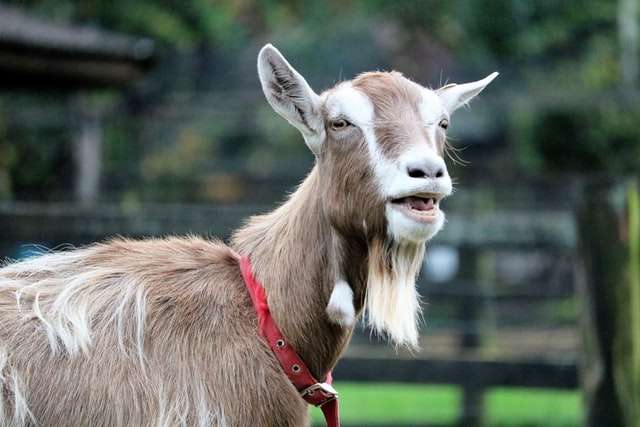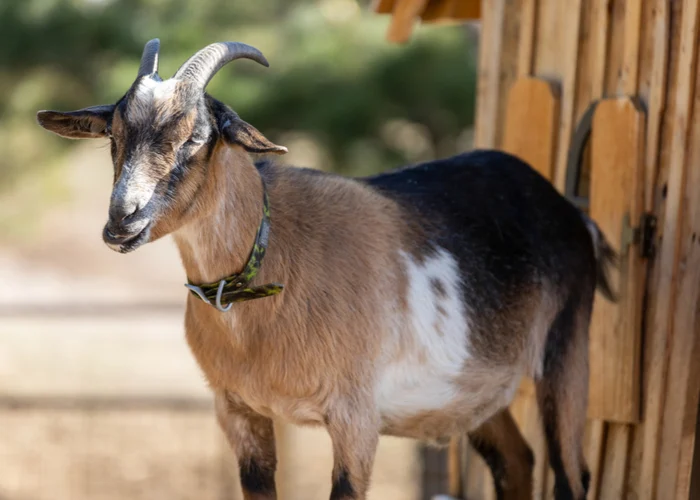
Description:
A goat with a medium size, the Toggenburg. They appear to be strong, active, and highly vigilant. Their hair is resting flat and is silky, fine, short, or medium in length. They have a uniform color that ranges from light fawn to dark chocolate without favouring any particular shade.
Toggenburg goats have specific white markings on their body in addition to a general Swiss Marked pattern with variable dilutions. The Toggenburg goat can be identified by its distinctive white markings, which include: white ears with a dark spot in the middle; white legs from the knees down with a dark line below knee acceptable; two white stripes down the face from above each eye to the muzzle; and a white triangle on either side of the tail.
Wattles, which are tiny, primitive skin bumps on each side of the neck, are frequently seen in Toggenburg goats. Moreover, if there are no wattles, a white spot could be found there or at the root of them.
Behavior:
Toggenburgs are incredibly alert and active, and they have distinct personalities and characters. They naturally form groups and are trainable as a breed, which makes them amenable to machine milking. The Toggenburg goats typically exhibit pleasant behavior and have calm, sensitive temperaments. The Toggenburg goat is a fairly hardy goat breed that is frequently quite interesting and inquisitive.
Considerations for commercial breeding include things like the flow of feed and fodder, the availability of feed, and market cycles. The natural estrus cycle is significantly influenced by nutrition, care, and management.
Benefits/Uses:
Although typically employed for milk production, these goats can also generate meat. Its milk is utilized in the creation of cheese and many other products. This goat milk has a fat level of 2-3%, which is comparable to some breeds of cow.
Origin/History:
The earliest dairy goat breed that has been identified is the Toggenburg. It came from the Toggenburg valley in the Swiss Canton of St. Gallen. And the breed was called for the region in Switzerland, from where the breed originated.
There are currently more than 300 different goat breeds available worldwide. The Toggenburg goat is regarded as the oldest breed out of all of these goat varieties. The breed is referred to as Togg. In 1892, Switzerland formally recognised the breed. Between the Werdenberg region and the Toggenburg Valley, 850 goats were counted as of 2006. 3,000 goats in total, down from 20,000 in the 1950s, are kept in Switzerland.

Keeping as pet:
- Housing
For the husbandry of Toggenburg goats, a good and comfortable home or shelter is essential. Therefore make an effort to build your goats a decent and cozy home. The Toggenburg goat breed, like many other domestic goat breeds, favours living in a dry, sterile environment. Building a raised house—one that is elevated above the ground—is thought to be advantageous for the Toggenburg goat rearing industry. Create the home in a way that makes it simple for you to clean it.
Build a reliable ventilation system and make sure there is enough air and light flowing within the home. Each Toggenburg goat will need a home area of about 12 square feet because they are a medium-sized breed. But if you want to raise them in a stall-fed method, they require more area for playing.
- Feeding
The most crucial aspect of the Toggenburg goat farming industry is providing the animals with food that is both of the highest quality and most nutritious. Thus, strive to always provide adequate high-quality food for your goats.
The Toggenburg goats need both grains and green meals because they are a kind of dairy goat. Nonetheless, they typically need more greens than grains.
Also, they need various vitamins and minerals. Hence, to get a better recommendation, speak with a local veterinarian. And always give the goats plenty clean, fresh water to drink as needed.
- Caring
The goats need additional care in addition to adequate amounts of nutrient-rich food and a safe place to live if they are to develop and produce more. Therefore make an effort to provide for your animals. Keep close contact with a veterinarian, deworm and vaccinate them as needed.
Table





